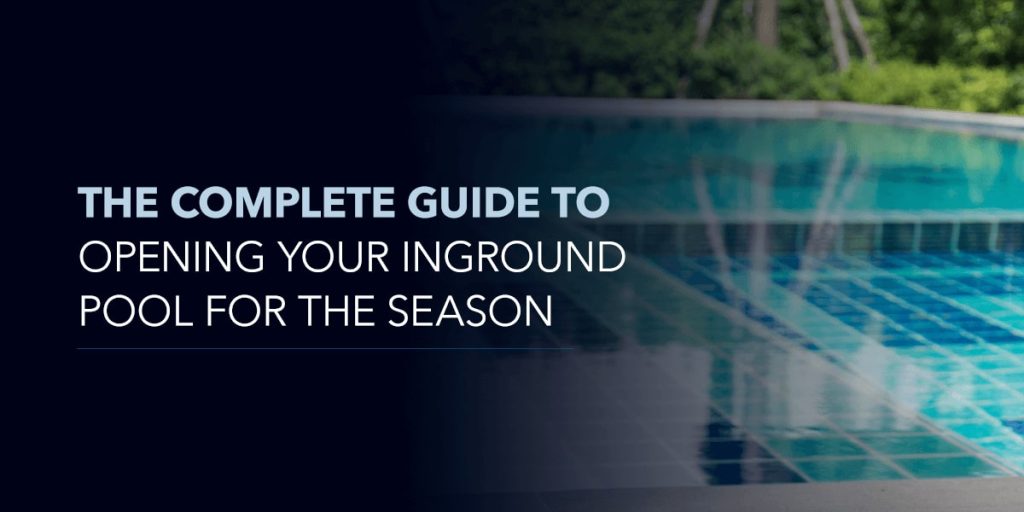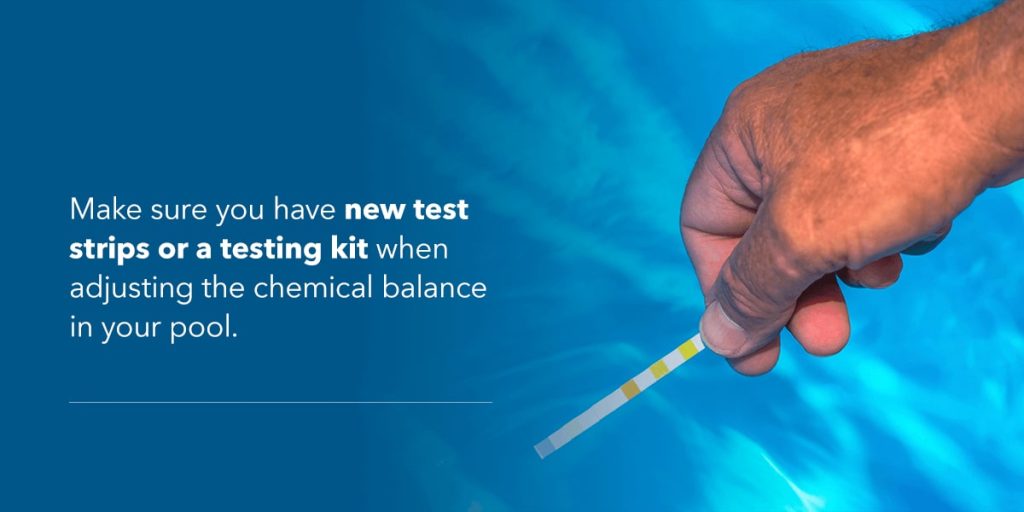

Opening your inground pool after winter is one of the first signs that longer days and warmer weather are right around the corner. After months of bleak, dreary weather, nothing sounds better than lounging by the pool on a sunny summer day.
To ensure safety for swimmers and your pool’s longevity, you must take specific pool opening steps and do everything right. Read our comprehensive guide to learn how to open an inground pool.
Before beginning the process of opening your pool, gather all the necessary equipment. Here are some supplies to make sure you have on hand.
You’ll need to follow multiple steps to open your inground pool after the winter.
Take all the water, leaves and debris off the pool cover. You can use a pool cover pump to remove the water and a soft broom for the leaves and debris. Be careful not to use anything that will damage the cover.
Remove the cover and spread it across your yard. Clean it with some soap and water, and scrub with a soft brush. Rinse the soap off, and allow the cover to dry before folding and storing in a closed container or storage bag.
Using your garden hose, fill the pool to its usual water level. After the water is back to the correct level, remove the debris from the pool. Make sure to get all larger debris that could clog your filtration system after you turn it back on.
If you installed winter drain plugs when closing your pool at the end of last season, remove them. Reinstall skimmer baskets if needed, and remove anything you use over the winter, like cushions to support the cover.
Re-attach all of your pool equipment, like stairs, diving boards, rails, etc.
Correctly set up your pump, filter and things like heaters and booster pumps. Reinstall drain plugs and use pool gasket lubricant on any O-rings to protect them. Power on the pump and filter and make sure everything is working correctly.
Let the filter run for 12 to 24 hours. This interval will allow the old water to mix with the new water before adding any chemicals. After 12 to 24 hours, clean the pool again using your pool net and brush.
Adding chemicals needed to open your pool can be tricky. Make sure you have new test strips or a testing kit when adjusting the chemical balance in your pool.
First, you want to balance the total alkalinity. To raise alkalinity, using baking soda or soda ash. To lower total alkalinity, use muriatic acid. The ideal range for total alkalinity is between 80 and 120 parts per million.
Next, balance the water’s pH. Use baking soda or soda ash to increase the pH, and use muriatic acid to decrease the pH. The ideal pH for your pool is 7.4.
After balancing the pH, focus on the calcium hardness. A low calcium hardness means that water is too soft and could corrode your pool surfaces. You can use sodium chloride to increase calcium hardness, but proceed with caution, as it is challenging to reduce your pool’s calcium levels. The correct calcium level should be between 200 and 400 parts per million.

After the alkalinity, pH and calcium hardness are at the correct levels, shock your pool. When opening your pool for the season, you typically double shock your pool. Shocking helps kill algae spores and bacteria and cleans your water. After shocking, the chlorine level should be 10 parts per million. If you notice cloudiness after shocking, add a water clarifier. Make sure you test your water one last time.
While you can open your inground pool on your own, hiring a professional to open your pool comes with significant benefits, specifically ensuring safety and saving you time and money.
Hiring professional service technicians to open your pool saves you time by allowing you to relax and not worry about all the tasks involved in ensuring your water is clean, clear and safe for everyone. All you have to do is wait for them to complete their work, then you can get back to enjoying your daily swims and backyard gatherings.
Professional pool openers also save you money in several ways. A highly trained pool crew knows how to take care of your pool and equipment. For example, pool covers can be pricey, and they require proper storage. A professional pool technician will take all the steps to remove, clean and store your pool cover for the summer.
Having a professional open your pool also saves you money if something goes wrong while opening your pool. When doing the work yourself, it can take time for someone to come and fix an issue, which could lead to more damages and money spent. If you hire a professional to open your pool, you can rest assured they have the tools and know-how to solve the issue.
Hiring a professional to open your pool also ensures safety. Pool chemicals can be tricky to work with, and levels must be correct to make your pool is safe and comfortable to use. Professionals know what chemicals to add in the right amounts to ensure everyone using your inground pool is safe all summer long.
Opening your pool for another summer is even more fun after your pool gets an upgrade. Adding a diving board, waterfall or slide can bring your pool to life. Fire features add some elegance to your poolside. They complement your home and provide light and warmth for those late-night swims.
Common water features to add to your inground pool include jets, waterfalls, waterwalls, scuppers, scones and bubblers. Features like waterfalls and waterwalls can help you maintain your pool’s chemical balance by circulating the water continuously. They also keep water cooler, which can extend your chlorine’s life.
If you would like to take the hard work out of opening your pool after the winter, work with the experienced team at Lotus Pools. We can handle all the tasks involved in opening your inground pool in spring, in addition to providing regular maintenance and closing services at the end of the season.
For over 10 years, Lotus Pools has been performing high-quality, reliable services at competitive rates. Our goal is to make sure your pool is in perfect condition. Begin enjoying your at-home retreat more comfortably. Contact Lotus Pools today and schedule a service call to get your inground pool open this spring.